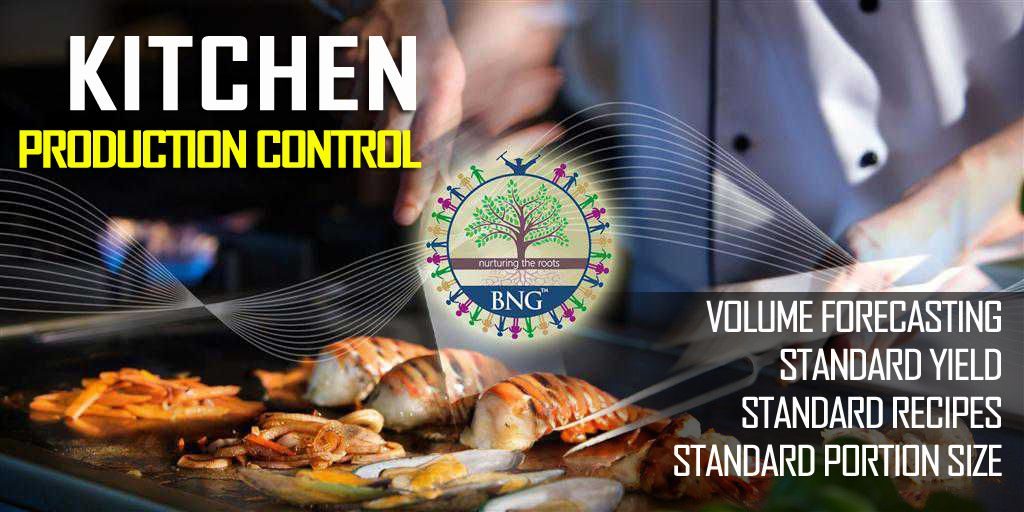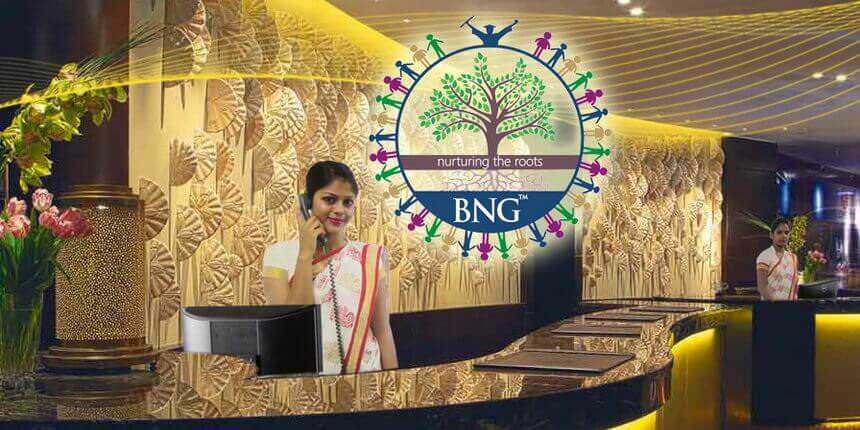Food Production Control and Volume Forecasting
Production control means the controlling of the preparation of food which together should reduce over-production (and possible waste), loss from inefficient purchasing and processing, and loss from excessive portion sizes. The proper operation of the food control system should aid management in controlling food costs efficiently and maximizing the profitability of the operation. There are four major stages in production control:—
- Volume Forecasting
- Standard Yield
- Standard Recipes
- Standard Portion Sizes.
Volume forecasting:
Volume forecasting is often referred to as production planning. It is a method of predicting the volume of sales for an establishment for a specified future period. The objectives of volume forecasting are:
- to predict the total number of meals to be sold in each selling outlet of an establishment at each meal period (e.g. the number of break-fasts to be served in the dining hall and the coffee shop and by floor service;
- to predict the choice of menu items by customers,
- to facilitate purchasing,
- to ensure availability of all necessary ingredients,
- to ensure that appropriate stock levels are held,
- to control food costs in relation to sales.
- to enable the food controller to compare the actual volume of business done by each of the selling outlet with the potential volume of business as forecast and for management to take action where necessary.
Volume forecasting is generally done in two stages—an initial forecast and final forecast.
The Initial Forecast
It is generally prepared a week in advance, and shows (a) the estimated total number of meals to be taken in each selling outlet; (b) the estimated total of each menu item; for each day of the following menu week. The initial forecast itself would be based on the following factors:
- Past Records (Sales Histories): In particular one would look at the figures recorded for the same period last year, examine the graph showing sales for last year to check if there is likelihood of a particular trend at this period on the year as well as looking the sales result for the last year. Also note the demand of different items of the menu and identify the items for which there has been no proportionate sale.
- Advance Bookings: A reference to the advance booking of the rooms and for the banquets would be valuable guide for the planning.
- Current Events: Annual trade fairs, sports meet, cricket match, the boat show, motor race etc. all such functions have an influence on the business done.
- Current Trends: What are the items on the menu which has increased or decreased demand? What are the items which you are not able to sell?
- The predicted sale of each menu item is converted into quantities of foodstuffs. The totals of each food item required for each meal period are itemized and listed and are used for writing out the requisition notes to the stores and purchasing department. Frequently, to convert the predicted sales of menu items in to quantities of food stuffs, standard recipe and portion conversion charts are used.
- The purchasing manager will use copy of the list together with the requisition order when placing the purchase order, taking into account at the same time, the economic ordering quantity for the item as well as the storage facilities for the establishment.
The Final Forecast
The final and more accurate forecast usually takes place the day before the preparation and service of the particular meal. This takes in to account the following:
- The previous day’s food production and food sales figures. If the actual food sales figures are in line with the potential food sales figure. At times food will be left over from previous day’s business which is perfectly edible and suitable for sale. Any left-over should be sold as soon as possible before they become a complete write-off.
- The weather conditions must be taken into account for the next day. As this forecast will be more accurate. A sudden change in the weather can effect the volume of business done g. rain, snow, very hot. A change in weather will affect customers choice.
(iii)The staffing requirement may be worked out very accurately when fairly precise production requirements are known. This assists not only in the preparation of staff rosters of duty, days-off, holidays etc. but may result in the total number of staff being reduced, thus saving in the kitchen and restaurant wages.
(iii)Waste is by far the leakage responsible for more financial failure of food operation than all other combined. To prevent waste avoid over-buying, over preparation, improper use of materials, careless preparation of material. Leakages can be reduced by keeping close watch on kitchen pantry, dining room and back-door. Food waste may be due to the poor quality of food purchased and due to short weight or measures, improper handling and storage of food after delivery.
(iv}Bad handling and bad storage of food promotes loss through dissipation of the value of a purchase; delay in using fresh vegetable leads to partial or complete deterioration; and even if utilized, such food assumes second hand value. Excessive stock held on storage deteriorates and affects the food cost adversely.
Faulty and incomplete preparation in preliminary and final stages causes waste.
Failure to standardize recipes, improper utilization of left-over foods, serving too large or too small portions and lack of adequate records on food cost or improper interpretation of such records all result in waste.
Standard Recipe:
Standard recipe is the method of standardizing recipes in such a way so that there is tight control on cost and quantity. Standardization should not be allowed to stifle the individual chef’s flair. A hotel can control quantities, quality and cost more easily. It is most useful to use standard recipe in a hotel where there are a number of chefs cooking the food. The standard recipe lays down all the ingredients, method of production and quantities used. It indicates the number of portions to be served. This will determine the size of portion or production control. A section giving variation can be added to reduce the total number of recipes required.
The main advantages in using a standard recipe are:—
- A well tried recipe ensures a consistently good finished product.
- It controls portion size which is very important in costing a dish.
- It is easy to determine the food cost of a particular dish.
- It simplifies the pricing of a particular dish.
- It reduces the possibility of error.
Production control:
A customer will continue to patronize a restaurant provided he gets correct ‘eight of the product he has paid for. On the other hand, the hotel’s return must e right and the price charged must be correct for the quantities of goods sold. The quantity is the portion size which the hotel has used in its costing in calculating \e selling price. The quantity sold for a given price must be consistently the same; he hotel should control this size to ensure that his costing is not invalidated.
production control means, the control of portion size to ensure those portions served are consistently of the same size as the portions costed. The main objectives of production controls are:—
- To ensure guest satisfaction
- To serve fair portion of food/beverages for a fair price
- To maintain profitability on all portions sold.
- In the food and beverage units the controlling the size of each unit of sale requires the use of suitable equipment such as :—
(v) In addition to use of proper equipment, production control requires three important things :—
- Standard Recipes
The articles being prepared must consist of the same ingredients every time. This is possible by use of standard recipes. A portion cannot be consistent even if it is of the same weight. This is particular so in case of a garnish. An expensive garnish on impulse can ruin the cost of a dish.
- Portion Charts
The service staff must be thoroughly conversant with the proper production control. For their convenience and ready reference, suitable portion size charts be prepared and displayed at convenient points in the kitchen. The portion for costing purpose may be expressed in weight but from server’s use it may be expressed in scoop.
- Regular Checking
Continuous and automatic supervision will develop habits and need no special efforts. Food and beverage controller should do regular spot checks on the food leaving the kitchen for quality, portion size and presentation. The number of portions should be cross-checked against the number of portions expected to be produced from the commodities used by the kitchen.
- Staff Instructions and Display of Charts
Portion charts should be displayed at convenient points in the producing centre as a constant reminder. Regular demonstration and visual training will encourage staff to be alert for variation in portion sizes.
- Pre-packed Food
Reproduced portion is yet another method of Production control in which food
is already made up into portion is served to customers. The individual production control concept is now very popular on almost all the food and beverage establishments. The main advantage of pre-packed and individual portions are:—
| (i) | Convenience |
| (ii) | Exact portion |
| (iii) | Accurate costing |
| (iv) | No preparation required |
| (V) | Saving of time |
| (Vi) | Saving of labour cost |
| (vii) | No wastage |
| (viii) | Hygienic preparation |
| (ix) | Food prepared in advance of use |
| (x) | Consistent and attractive preparation of individual portions. |
Fish, meat, vegetables and other products such as jams, marmalades, honey, sauces and dressings, dairy products (butter, cheese, milk, cream/condiments, salt, pepper, mustard, sugar etc.) are now being pre-packed in individual portions.
Production control and Standard Portion Size:
The menu price of food items is based on the cost of the standard portion of food required to prepare them. A standard portion size is the quantity of a particular food item that could be served to the guest. This quantity may be expressed in terms of weight (ounces) or in numerical figures. The standard size of food item may be determined by the management in conjunction with the executive chef and restaurant manager.
The chefs and supervisors should be responsible to instruct their staff on the correct use of equipment and explain why it is necessary to adhered to the correct portion sizes.
Large hotels and food and beverage units employ highly developed production control methods and ensure that portions served are consistent to the same size as the portion costed. The actual size of the portion is a matter of policy decided by the management. The main objective of the production control is to ensure that the decisions made by the management are adhered to consistently.
Determinants of Portion Sizes for Production control:
Size of portions is to be decided according to the nature of establishment, the type of customers, and type of food and beverage items handled by the establishments. In brief following points should be considered:—
- The type of customers
- The type of food and beverage operations
- Spending power of the consumers.
Determination of menu price for better Production control:
The menu price could be determined by using portion divider. For this purpose following information are required:-
- Purchase Price
- Portion Size
- Yield Percentage
- Food Cost Percentage Desired or menu Price
Portion Sizes and Production control:
Restaurants may find that a large portion of their business is accounted for by customers who prefer to change their meals. Obviously, with profit margins in the neighbourhood of 5%, an additional 6% charge would wipe out any profit. In order to cover this additional expense it is necessary for menu prices to be increased by an additional amount. The increase need not be the full 6% charge, since some customers will still pay in cash and an extra profit will be realized on these sales.
The per cent of the increase should reflect the proportion of the business that is done in credit sales. If 50% of the sales are on credit, then a 3% increase would be justified. If 75% of the sales are on credit, many operators choose to absorb the difference. Although this may be possible, the net profits will change, and the true value of extending credit should be closely examined to determine if an adjustment should be made. With the wide range of portion sizes for any given item, it is possible for the food cost of any operation to be controlled in such a manner that the operating food cost percentage can be adjusted or changed by adjusting portion sizes.






